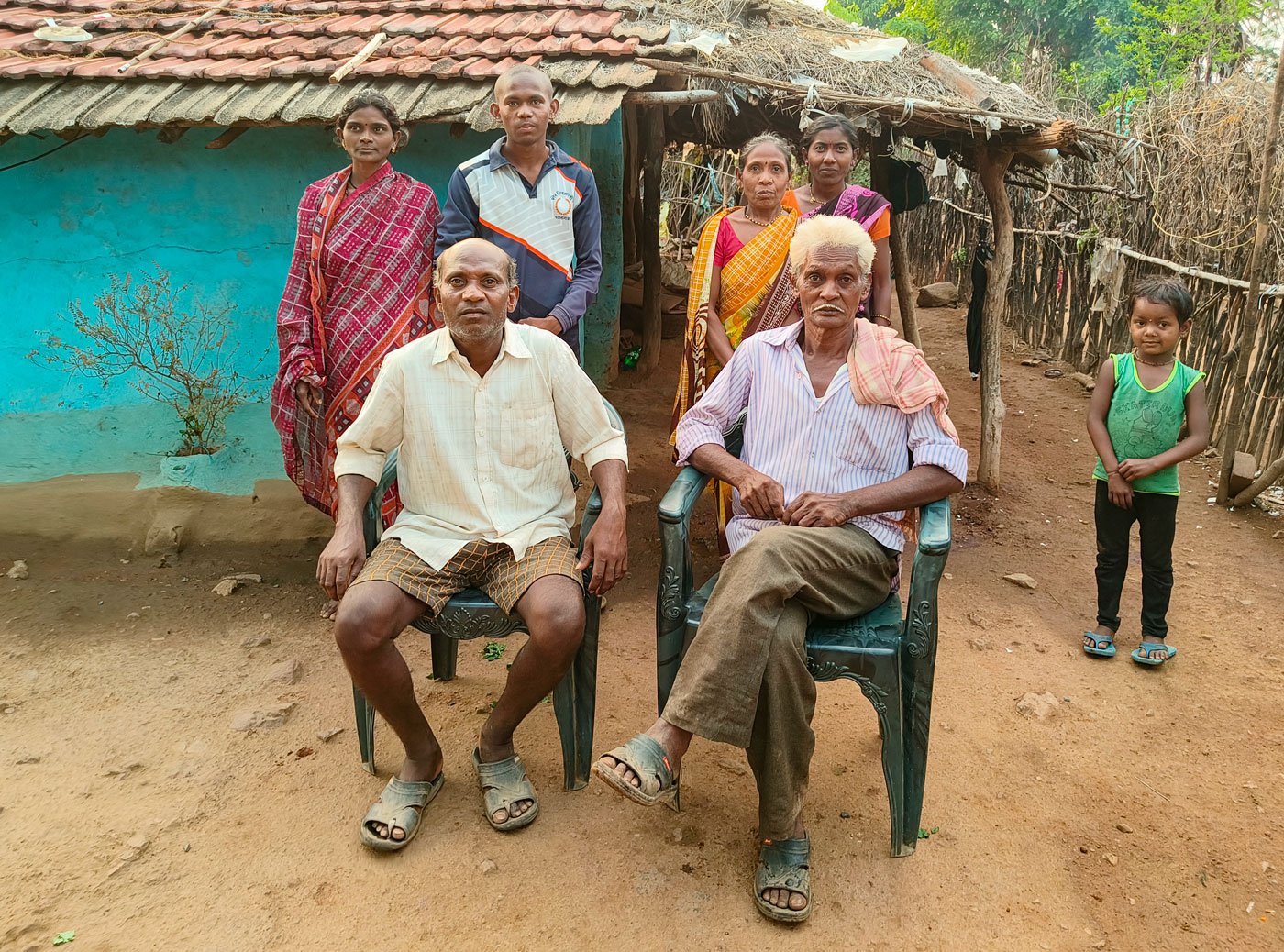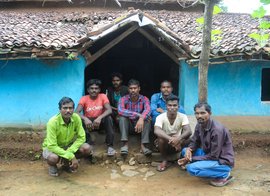Sitting quietly on a chair inside his home, Goma Rama Hazare is whiling away his time, staring listlessly at the empty main road of his village.
Once in a while, he chit-chats with the passers-by who drop in to check on his well-being. The man lost his wife from a protracted illness just about a week ago.
It’s 5 p.m., mid-April (2024), and very hot. Palasgaon, a village in the lap of rich bamboo and teak forests of Armori tehsil in north Gadchiroli is exceptionally quiet. Voting for the Gadchiroli-Chimur Lok Sabha constituency is due in a few days. The sitting BJP MP Ashok Nete is contesting for this seat again. But there’s no excitement. In fact, there’s worry.
For the past two months, Goma has had no work. Usually, during this time, the landless labourer in his early 60s and many like him would be collecting mahua or tendu or cutting bamboo in the forest or doing farm work.
“Not this year,” Goma says. “Who’ll risk their life?”
“People are keeping to themselves at home,” Goma says. Days are hot. You can’t go out. Many villages are used to such curfews as Gadchiroli has been troubled by an armed conflict for four decades and torn by a bloody strife between the security forces and the armed Maoists. But this time the guests are different and pose a direct threat to life and livelihoods.
A herd of 23 wild
elephants, mostly female with young calves, is camping in the vicinity of Palasgaon.


Goma Rama Hazare (left), a landless farmer in Palasgaon, Maharashtra, has had to forgo his livelihood due to the presence of a wild
elephant herd in the vicinity of his village this summer, even as the elections
for the Lok Sabha are underway. The villagers are more worried about the wild tuskers than who they vote into the parliament. He and his family will lose Rs. 25,000 per
head on an average in two months for not being able to collect
mahua
and
tendu


Left: Hazare walking down an empty street in Palasgaon. Right: The village wears a near desolate look as the mercury soars in mid-April. In some homes, mahua flowers are being dried in the sun; these flowers have been collected from the farms close by. Normally, the village would be full of mahua and tendu leaves at this time. Not this year
For a month or so, the herd, which trudged all the way from north Chhattisgarh, has been feasting on the shrub and bamboo forests and paddy crops here, putting the villagers and district forest officials on tenterhooks. Around four years ago, these mammals entered the eastern Vidarbha region of Maharashtra as mining and deforestation were affecting their natural habitat and corridors up north.
Moving across the three districts of Gondia, Gadchiroli and Chandrapur in Maharashtra and Bastar in Chhattisgarh, part of the erstwhile ‘Dandakaranya’, the elephants – members of a larger herd in Chhattisgarh that experts say perhaps got separated – is a new addition to the state’s wildlife.
Gadchiroli district did have some trained elephants in southern parts helping the forest department in their transportation work, but the eastern parts of Maharashtra are seeing the return of the wild tuskers after over a century and a half or perhaps more. The presence of wild elephants is common to the western ghats.
Forest officials have asked the Palasgaon villagers – mostly tribal households – to stay home until the guests migrate to another location. And so, landless people and small farmers of this village of 1400 people (Census 2011) and the neighbouring villages like Vihirgaon have had to forgo their forest-based livelihoods.
The state forest department compensates for the crop loss immediately, but there is no compensation for the loss of income from forest produce.
“My family subsists on mahua and tendu the entire summer,” Goma says.
With that income avenue
gone, Palasgaon can only hope that the wild elephants move on, allowing people to
get back to work.


Left: Forest officials have asked the residents of Palasgaon to wait for the tuskers to migrate to another location before resuming work. Right: Fulchand Waghade, a farmer from Palasgaon, suffered losses last season. His three-acre farmland was flattened by the elephants, he says
“The herd did not cross over to Chhattisgarh as they did in the last three summers,” says S Rameshkumar, the Chief Conservator of Forest (CCF), Gadchiroli. “Maybe because one of the females gave birth to a calf a few days ago.”
There are a couple of offsprings in the herd, he says. Elephants are matriarchal.
Last year (2023), the same herd rummaged through the 11-household hamlet of Nangal-doh in the neighbouring Arjuni Morgaon tehsil of Gondia district, about 100 km from Palasgaon, where it stayed for a few months in the dense forests.
“Not a single hut survived the fury of the tuskers that night,” remembers Vijay Madavi, among the people now living on an encroached piece of land near Bharnoli village. “They came knocking in the middle of the night,” he remembers.
Nangal-doh was evacuated that night and people shifted to the zilla parishad school in Bharnoli, where they stayed all through the summer of 2023. When the school restarted after the summer vacations, they cleared a portion of forest land on the village outskirts and built temporary huts sans electricity or water. Women walk a few miles to fetch water from a farm well. But all the villagers have lost their small patches of farmland that they once tilled after clearing the shrub forests.
“When will we get a house of our own?” asks Usha Holi, another evacuee, as they await rehabilitation package and a permanent home.
Across these three
districts, as the tuskers shift their location, farmers reel with crop losses,
something that was never a problem.


Wild elephants destroyed the huts of all residents of Nangal-doh hamlet in Arjuni Morgaon tehsil in Gondia district last summer (2023). The 11 families have set up temporary huts on a patch of forest land in the nearby village of Bharnoli. They are waiting for a rehabilitation and compensation package from the state government
Underlining the complexity of managing a wild elephant herd in north Gadchiroli region, Rameshkumar says the north of India is very densely populated, unlike a sparser south. The biggest problem is crop-depredation. The tuskers come out of their zone in the evenings and trample over the standing crop, even if they don’t eat it.
The forest officials have a quick response tracking team and early warning groups on the field following the herd round the clock with the help of drones and thermal imaging. They alert the villagers when the elephants are on the move to avoid any conflict or accidental confrontation.
Come evening, Nitin Mane, a farmer with seven acres of land in Palasgaon, and a group of five villagers join the hulla gang for the night vigil. Led by the forest guard Yogesh Pandaram, he moves around the forests tracking the wild elephants. Hulla gangs, experts in managing the wild elephants, have been hired from West Bengal to assist the local officials and train the village youth in the management of this herd. They man two drones in the field to keep an aerial eye on the tuskers, Nitin says, and walk around the elephants after having spotted their location.
“Some villagers have
been roped in to the
Hulla
gang to shoo away the elephants if they try
and enter the village,” says Palasgaon’s first-time woman
sarpanch
Jayashri
Dadhmal, a Mana adivasi. “But it has become my headache; people complain to me
about elephants and take out their frustration on me,” she says. “How am I
responsible for the elephants?”


Left: Nitin Mane, a young farmer in Palasgaon, is part of the hulla gang, a quick response team, roped in by the forest department to track the wild elephants with the help of drones and shoo them away if the herd tries to enter the village. Right: A team of forest offiicers and hulla gang members gearing up for the night vigil


Jayashri Dadhmal, the sarpanch of Palasgaon, brings a basket-full of mahua from her farm, but can’t go into the forest to collect any produce because of the risk posed by the presence of wild elephants
The catch is, when normalcy returns to Palasgaon, the villages in whose vicinity the wild tuskers find home will be in a bind. Forest officials say the region will have to learn to deal with the wild elephants as a new way of life and living.
Jayashri sympathises with the villagers as she herself has had to forgo mahua collection from the forest this year. “We may not get to collect tendu leaves because of the elephants,” she says. Each family will lose at least Rs. 25,000 over two months, she estimates based on her earnings.
“ Pahilech mahagai dokyavar aahe, aata hatti aale, ka karave aamhi ?” asks Goma. “Inflation was already a problem, now we have elephants, what do we do?”
There are no easy answers, only more questions.
The most important of them is not who enters the parliament, but who leaves the forests soon.
(The Gadchiroli-Chimur
Loksabha constituency, reserved for the Scheduled Tribes (ST), voted on April
19 in the first phase with 71.88 per cent turnout).



